On the Design and Analysis of Compact Super-Wideband Quad Element Chiral MIMO Array for High Data Rate Applications
Abstract
:1. Introduction
- (1)
- The designed MIMO antenna operates from 2.9 to more than 30 GHz, which corresponds to a bandwidth greater than 27 GHz;
- (2)
- The bandwidth (GHz and %) of this proposed antenna is greater than all the other antennas referenced in Table 1;
- (3)
- (4)
- (5)
- This work also focused on the DG and ECC of the MIMO configuration. DG was not reported in [17,20,21,22,23,27,28,29,30,31], and a higher DG value is shown when compared with [24,34]. The ECC values were not reported in [21,23,27,28,30,31]. Due to the better isolation characteristics, the proposed antenna provides lower ECC compared with [17,18,19,20,22,24,25,29,32,33,34];
- (6)
- Due to the compact geometry and wider bandwidth, the proposed antenna offers higher a BDR value, compared with the other work referred to in the table.
2. Antenna Design
2.1. Unit Cell Design
2.2. MIMO Antenna Design
3. Results and Discussion
3.1. Radiation Characteristics Realization of the MIMO Antenna
3.2. Performance Metrics of the Proposed Diversity Antenna
4. Conclusions
Author Contributions
Funding
Acknowledgments
Conflicts of Interest
References
- Deng, C.; Xie, Y.-J.; Li, P. CPW-Fed Planar Printed Monopole Antenna with Impedance Bandwidth Enhanced. IEEE Antennas Wirel. Propag. Lett. 2009, 8, 1394–1397. [Google Scholar] [CrossRef]
- Manohar, M.; Kshetrimayum, R.S.; Gogoi, A.K. Super wideband antenna with single band suppression. Int. J. Microw. Wirel. Technol. 2015, 9, 143–150. [Google Scholar] [CrossRef] [Green Version]
- Srivastava, K.; Kumar, A.; Kanaujia, B.K.; Dwari, S.; Kumar, S. A CPW fed UWB MIMO antenna with integrated GSM band and Dual band notches. Int. J. RF Microw. Comput. Aided Eng. 2018. [Google Scholar] [CrossRef] [Green Version]
- Chen, K.-R.; Sim, C.-Y.-D.; Row, J.-S. A Compact Monopole Antenna for Super Wideband Applications. IEEE Antennas Wirel. Propag. Lett. 2011, 10, 488–491. [Google Scholar] [CrossRef]
- Manohar, M.; Kshetrimayum, R.S.; Gogoi, A.K. Printed monopole antenna with tapered feed line, feed region and patch for super wideband applications. IET Microw. Antennas Propag. 2014, 8, 39–45. [Google Scholar] [CrossRef] [Green Version]
- Chandel, R.; Gautam, A.K.; Rambabu, K. Tapered Fed Compact UWB MIMO-Diversity Antenna with Dual Band-Notched Characteristics. IEEE Trans. Antennas Propag. 2018, 66, 1677–1684. [Google Scholar] [CrossRef]
- Rahman, M.; Haider, A.; Naghshvarianjahromi, M. A Systematic Methodology for the Time-Domain Ringing Reduction in UWB Band-Notched Antennas. IEEE Antennas Wirel. Propag. Lett. 2020, 19, 482–486. [Google Scholar] [CrossRef]
- Srifi, M.N.; El Mrabet, O.; Falcone, F.; Ayza, M.S.; Essaaidi, M. A Novel Compact Printed Circular Antenna for Very Ultra wideband Applications. Microw. Opt. Technol. Lett. 2009, 51, 1130–1134. [Google Scholar] [CrossRef]
- John, M.; Ammann, M.J. Optimization of impedance bandwidth for the printed rectangular monopole antenna. Microw. Opt. Technol. Lett. 2005, 47, 153–154. [Google Scholar] [CrossRef] [Green Version]
- Ammann, M.J. Control of the impedance bandwidth of wideband planar monopole antennas using a beveling technique. Microw. Opt. Technol. Lett. 2001, 30, 229–232. [Google Scholar] [CrossRef]
- Bao, X.L.; Ammann, M.J. Investigation on UWB printed monopole antenna with rectangular slitted groundplane. Microw. Opt. Technol. Lett. 2007, 49, 1585–1587. [Google Scholar] [CrossRef]
- Kimouche, H.; Abed, D.; Atrouz, B.; Aksas, R. Bandwidth enhancement of rectangular monopole antenna using modified semi-elliptical ground plane and slots. Microw. Opt. Technol. Lett. 2010, 52, 54–58. [Google Scholar] [CrossRef]
- Kumar, S.; Lee, G.H.; Kim, D.H.; Haunan, N.S.; Choi, H.C.; Kim, K.W. Compact Planar Super-Wideband Monopole Antenna with Four Notched Bands. Electronics 2020, 9, 1204. [Google Scholar] [CrossRef]
- Haider, A.; Rahman, M.; Naghshvarianjahromi, M.; Kim, H.S. Time-Domain Investigation of Switchable Filter Wide-Band Antenna for Microwave Breast Imaging. Sensors 2020, 20, 4302. [Google Scholar] [CrossRef]
- Sarkar, D.; Srivastava, K.V. A Compact Four-Element MIMO/Diversity Antenna with Enhanced Bandwidth. IEEE Antennas Wirel. Propag. Lett. 2017, 16, 2469–2472. [Google Scholar] [CrossRef]
- Palaniswamy, S.K.; Kanagasabai, M.; Kumar, S.A.; Alsath, M.G.N.; Velan, S.; Pakkathillam, J.K. Super wideband printed monopole antenna for ultra wideband applications. Int. J. Microw. Wirel. Technol. 2015, 9, 133–141. [Google Scholar] [CrossRef]
- Liu, L.; Cheung, S.W.; Yuk, T.I. Compact MIMO Antenna for Portable Devices in UWB Applications. IEEE Trans. Antennas Propag. 2013, 61, 4257–4264. [Google Scholar] [CrossRef] [Green Version]
- Zhang, S.; Ying, Z.; Xiong, J.; He, S. Ultra wideband MIMO/Diversity Antennas with a Tree-Like Structure to Enhance wideband isolation. IEEE Antennas Wirel. Propag. Lett. 2009, 8, 1279–1281. [Google Scholar] [CrossRef]
- Mohammed, G.N.A.; Kanagasabai, M. Compact UWB Monopole Antenna for Automotive Communications. IEEE Trans. Antennas Propag. 2015, 63, 4204–4208. [Google Scholar]
- Jusoh, M.; Bin Jamlos, M.F.; Bin Kamarudin, M.R.; Malek, M.F.B.A. A Mimo Antenna Design Challenges for Uwb Application. Prog. Electromagn. Res. B 2012, 36, 357–371. [Google Scholar] [CrossRef] [Green Version]
- Li, Q.; Feresidis, A.P.; Mavridou, M.; Hall, P.S. Miniaturized Double-Layer EBG Structures for Broadband Mutual Coupling Reduction Between UWB Monopoles. IEEE Trans. Antennas Propag. 2015, 63, 1168–1171. [Google Scholar] [CrossRef]
- Babu, K.V.; Anuradha, B. Design of MIMO antenna to interference inherent for ultra wide band systems using defected ground structure. Microw. Opt. Technol. Lett. 2019, 61, 2698–2708. [Google Scholar] [CrossRef]
- Radhi, A.H.; Nilavalan, R.; Wang, Y.; Al-Raweshidy, H.S.; Eltokhy, A.A.; Ab Aziz, N. Mutual coupling reduction with a wideband planar decoupling structure for UWB–MIMO antennas. Int. J. Microw. Wirel. Technol. 2018, 10, 1143–1154. [Google Scholar] [CrossRef] [Green Version]
- Iqbal, A.; Saraereh, O.A.; Ahmad, A.W.; Bashir, S. Mutual Coupling Reduction Using F-Shaped Stubs in UWB-MIMO Antenna. IEEE Access 2018, 6, 2755–2759. [Google Scholar] [CrossRef]
- Gurjar, R.; Upadhyay, D.K.; Kanaujia, B.K.; Sharma, K. A novel compact self-similar fractal UWB MIMO antenna. Int. J. RF Microw. Comput. Eng. 2019, 29, e21632. [Google Scholar] [CrossRef]
- Ali, W.A.; Ibrahim, A.A. A compact double-sided MIMO antenna with an improved isolation for UWB applications. AEU—Int. J. Electron. Commun. 2017, 82, 7–13. [Google Scholar] [CrossRef]
- Kiem, N.K.; Phuong, H.N.B.; Chein, D.N. Design of compact 4×4 UWB-MIMO antenna with WLAN band rejection. Int. J. Antennas Propag. 2014, 2014, 1–11. [Google Scholar] [CrossRef]
- Lin, S.-Y.; Huang, H.-R. Ultra-wideband MIMO antenna with enhanced isolation. Microw. Opt. Technol. Lett. 2008, 51, 570–573. [Google Scholar] [CrossRef]
- Mathur, R.; Dwari, S. Compact CPW-Fed ultrawideband MIMO antenna using hexagonal ring monopole antenna elements. AEU—Int. J. Electron. Commun. 2018, 93, 1–6. [Google Scholar] [CrossRef]
- Saad, A.A.R. Approach for improving inter-element isolation of orthogonally polarised MIMO slot antenna over ultra-wide bandwidth. Electron. Lett. 2018, 54, 1062–1064. [Google Scholar] [CrossRef]
- Zhu, J.; Li, S.; Feng, B.; Deng, L.; Yin, S. Compact Dual-Polarized UWB Quasi-Self-Complementary MIMO/Diversity Antenna with Band-Rejection Capability. IEEE Antennas Wirel. Propag. Lett. 2016, 15, 905–908. [Google Scholar] [CrossRef]
- Hasan, N.; Chu, S.; Bashir, S. A DGS monopole antenna loaded with U-shape stub for UWB MIMO applications. Microw. Opt. Technol. Lett. 2019, 61, 2141–2149. [Google Scholar] [CrossRef]
- Singhal, S. Four element ultra-wideband fractal multiple-input multiple-output antenna. Microw. Opt. Technol. Lett. 2019, 61, 2811–2818. [Google Scholar] [CrossRef]
- Tiwari, R.N.; Singh, P.; Kanaujia, B.K.; Srivastava, K. Neutralization technique based two and four port high isolation MIMO antennas for UWB communication. AEU—Int. J. Electron. Commun. 2019, 110. [Google Scholar] [CrossRef]
- Mishra, M.; Chaudhuri, S.; Kshetrimayum, R.S.; Chel, H. Low mutual coupling six-port planar antenna for the MIMO applications. Int. J. RF Microw. Comput. Eng. 2020, 30. [Google Scholar] [CrossRef]
- Raheja, D.K.; Kanaujia, B.K.; Kumar, S. Low profile four-port super-wideband multiple-input-multiple-output antenna with triple band rejection characteristics. Int. J. RF Microw. Comput. Eng. 2019, 29. [Google Scholar] [CrossRef]
- Yadav, R.; Malviya, L. UWB antenna and MIMO antennas with bandwidth, band-notched, and isolation properties for high-speed data rate wireless communication: A review. Int. J. RF Microw. Comput. Eng. 2019, 30. [Google Scholar] [CrossRef]
- Chouhan, S.; Panda, D.K.; Gupta, M.; Singhal, S. Multiport MIMO antennas with mutual coupling reduction techniques for modern wireless transreceive operations: A review. Int. J. RF Microw. Comput. Eng. 2018, 28, e21189. [Google Scholar] [CrossRef]
- Mao, C.-X.; Chu, Q.-X. Miniaturization of UWB antenna by asymmetrically extending stub from ground. J. Electromagn. Waves Appl. 2014, 28, 531–541. [Google Scholar] [CrossRef]
- Kumar, R.; Pazare, N. A CPW-fed stepped slot UWB antenna for MIMO/diversity applications. Int. J. Microw. Wirel. Technol. 2015, 9, 151–162. [Google Scholar] [CrossRef]
- Khan, M.S.; Shoaib, I.; Autizi, E.; Capobianco, A.-D.; Najam, A.I.; Shafique, M.F. Compact ultra-wideband diversity antenna with a floating parasitic digitated decoupling structure. IET Microw. Antennas Propag. 2014, 8, 747–753. [Google Scholar] [CrossRef]
- Gnanaharan, I.; Anbazhagan, R. Review on the Design of the Isolation Techniques for UWB-MIMO Antennas. Adv. Electromagn. 2018, 7, 46–70. [Google Scholar] [CrossRef]
- Palaniswamy, S.K.; Selvam, Y.P.; Alsath, M.G.N.; Kanagasabai, M.; Kingsly, S.; Subbaraj, S. 3-D Eight-Port Ultrawideband Antenna Array for Diversity Applications. IEEE Antennas Wirel. Propag. Lett. 2016, 16, 569–572. [Google Scholar] [CrossRef]
- Chen, Z.N.; See, T.S.P.; Qing, X. Small Printed Ultrawideband Antenna with Reduced Ground Plane Effect. IEEE Trans. Antennas Propag. 2007, 55, 383–388. [Google Scholar] [CrossRef]
- Tirado-Mendez, J.A.; Gómez-Villanueva, R.; Jardón-Aguilar, H.; Fritz-Andrade, E.; Rangel-Merino, A. UWB MIMO antenna implemented with orthogonal quasi-circular slot dipole radiators. Int. J. RF Microw. Comput. Eng. 2019, 29. [Google Scholar] [CrossRef]
- Khan, A.A.; Jamaluddin, M.H.; Nasir, J.; Khan, R.; Aqeel, S.; Saleem, J. Owais design of a dual-band mimo dielectric resonator antenna with pattern diversity for Wimax and Wlan applications. Prog. Electromagn. Res. M 2016, 50, 65–73. [Google Scholar] [CrossRef] [Green Version]
- Fritz-Andrade, E.; Jardon-Aguilar, H.; Tirado-Mendez, J.A. The correct application of total active reflection coefficient to evaluate MIMO antenna systems and its generalization to N ports. Int. J. RF Microw. Comput. Eng. 2020, 30. [Google Scholar] [CrossRef]
- Wang, F.; Li, S.; Zhou, Q.; Gong, Y.-B. Compact Wideband Quad-Element Mimo Antenna with Reversed S-Shaped Walls. Prog. Electromagn. Res. M 2019, 78, 193–201. [Google Scholar] [CrossRef] [Green Version]
- Sampath, R.; Selvan, K.T. Compact hybrid Sierpinski Koch fractal UWB MIMO antenna with pattern diversity. Int. J. RF Microw. Comput. Eng. 2019. [Google Scholar] [CrossRef]
- Pannu, P.; Sharma, D.K. A low-profile quad-port UWB MIMO Antenna using defected ground structure with dual notch-band behaviour. Int. J. RF Microw. Comput. Aided Eng. 2020, 30, e22288. [Google Scholar] [CrossRef]
- Saadh, A.M.; Ashwath, K.; Ramaswamy, P.; Ali, T.; Anguera, J. A uniquely shaped MIMO antenna on FR4 material to enhance isolation and bandwidth for wireless applications. AEU—Int. J. Electron. Commun. 2020, 123, 153316. [Google Scholar] [CrossRef]
- Payandehjoo, K.; Abhari, R. Highly-isolated unidirectional multi-slot-antenna systems for enhanced MIMO performance. Int. J. RF Microw. Comput. Eng. 2013, 24, 289–297. [Google Scholar] [CrossRef]
- Alsath, M.G.N.; Arun, H.; Selvam, Y.P.; Kanagasabai, M.; Kingsly, S.; Subbaraj, S.; Sivasamy, R.; Palaniswamy, S.K.; Natarajan, R.; Alsath, M.G.N. An Integrated Tri-Band/UWB Polarization Diversity Antenna for Vehicular Networks. IEEE Trans. Veh. Technol. 2018, 67, 5613–5620. [Google Scholar] [CrossRef]
- Kumar, M.; Nath, V. A high BDR microstrip-line fed antenna with multiple asymmetric elliptical wide-slots for wideband applications. Int. J. RF Microw. Comput. Eng. 2020, 30. [Google Scholar] [CrossRef]
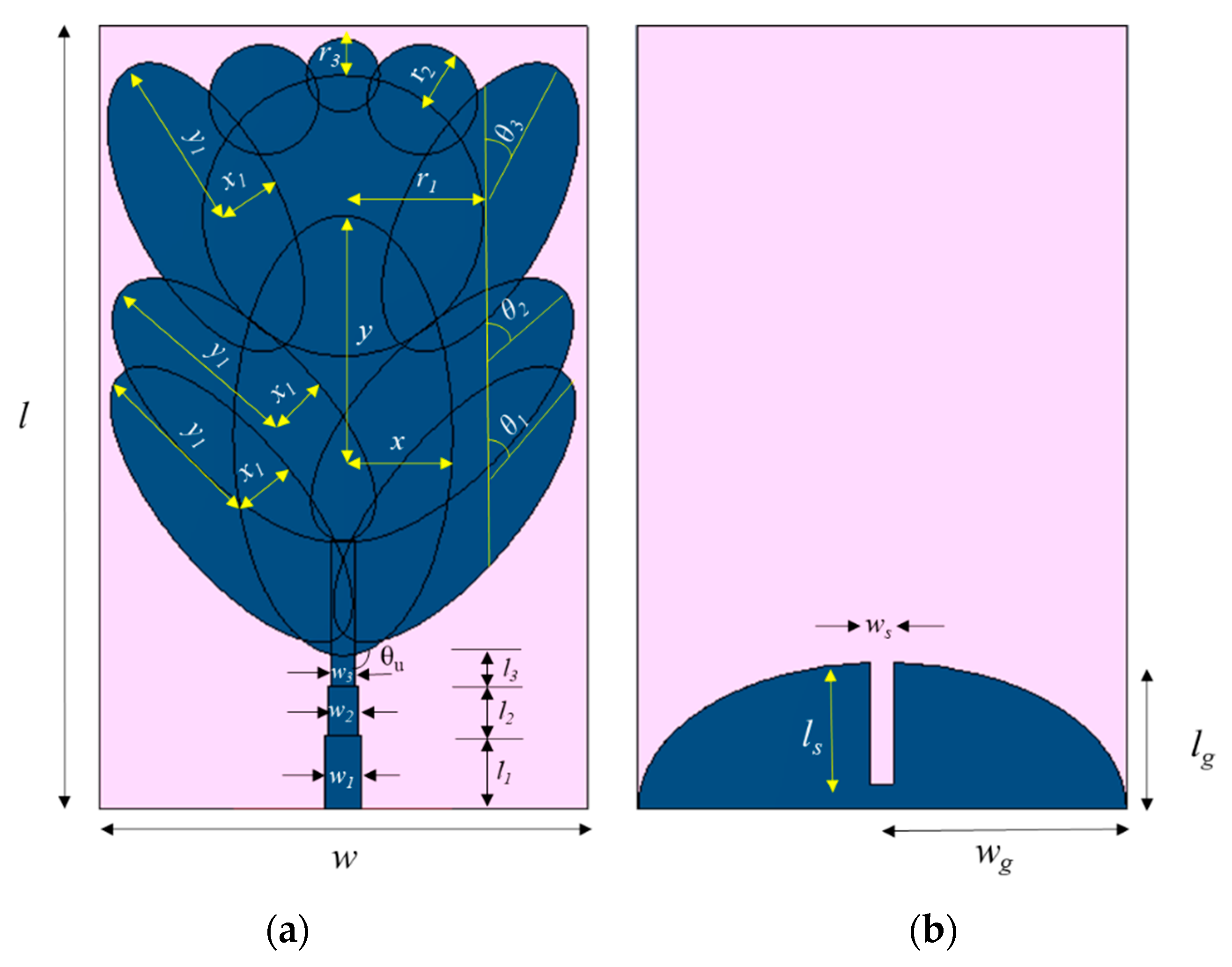
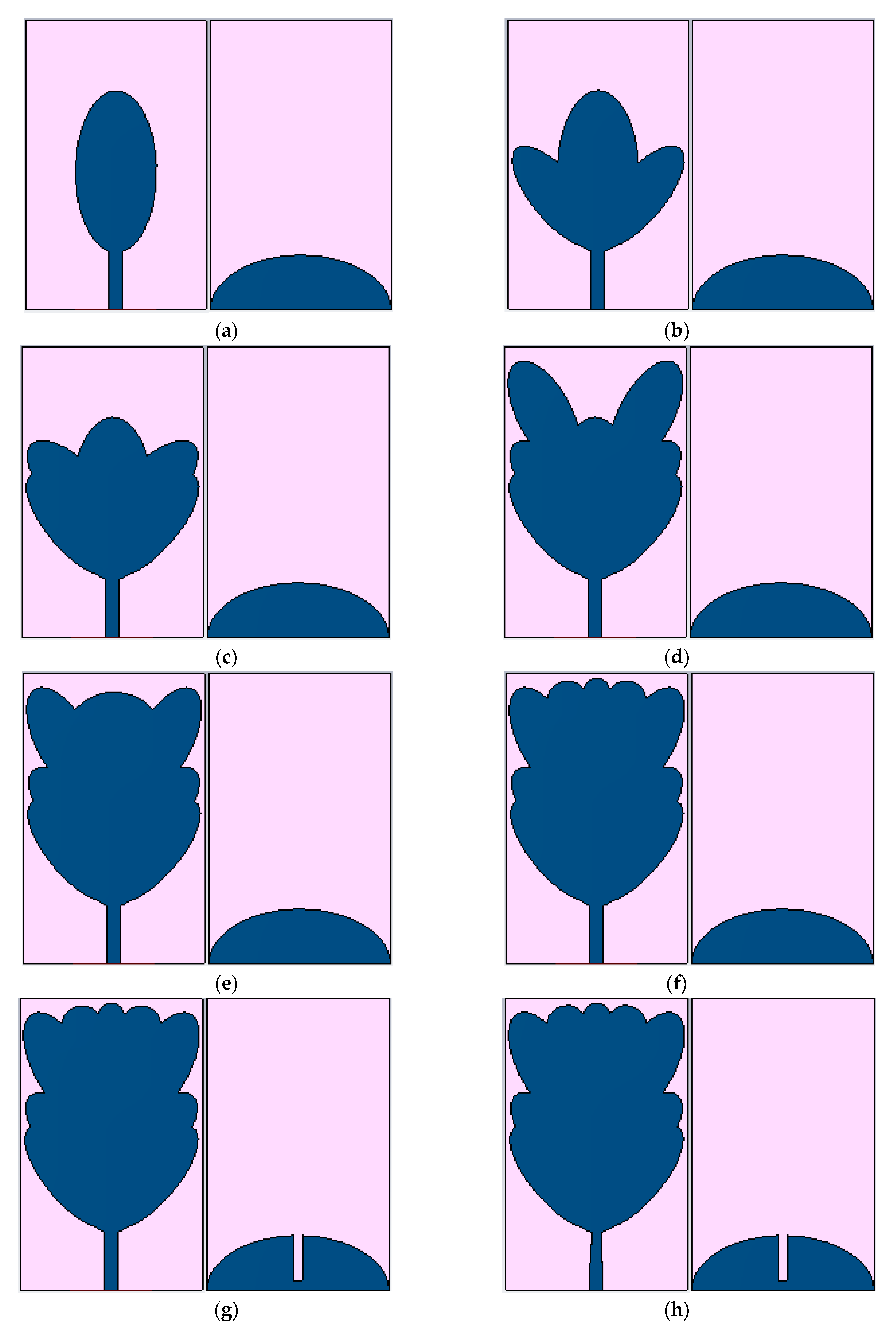
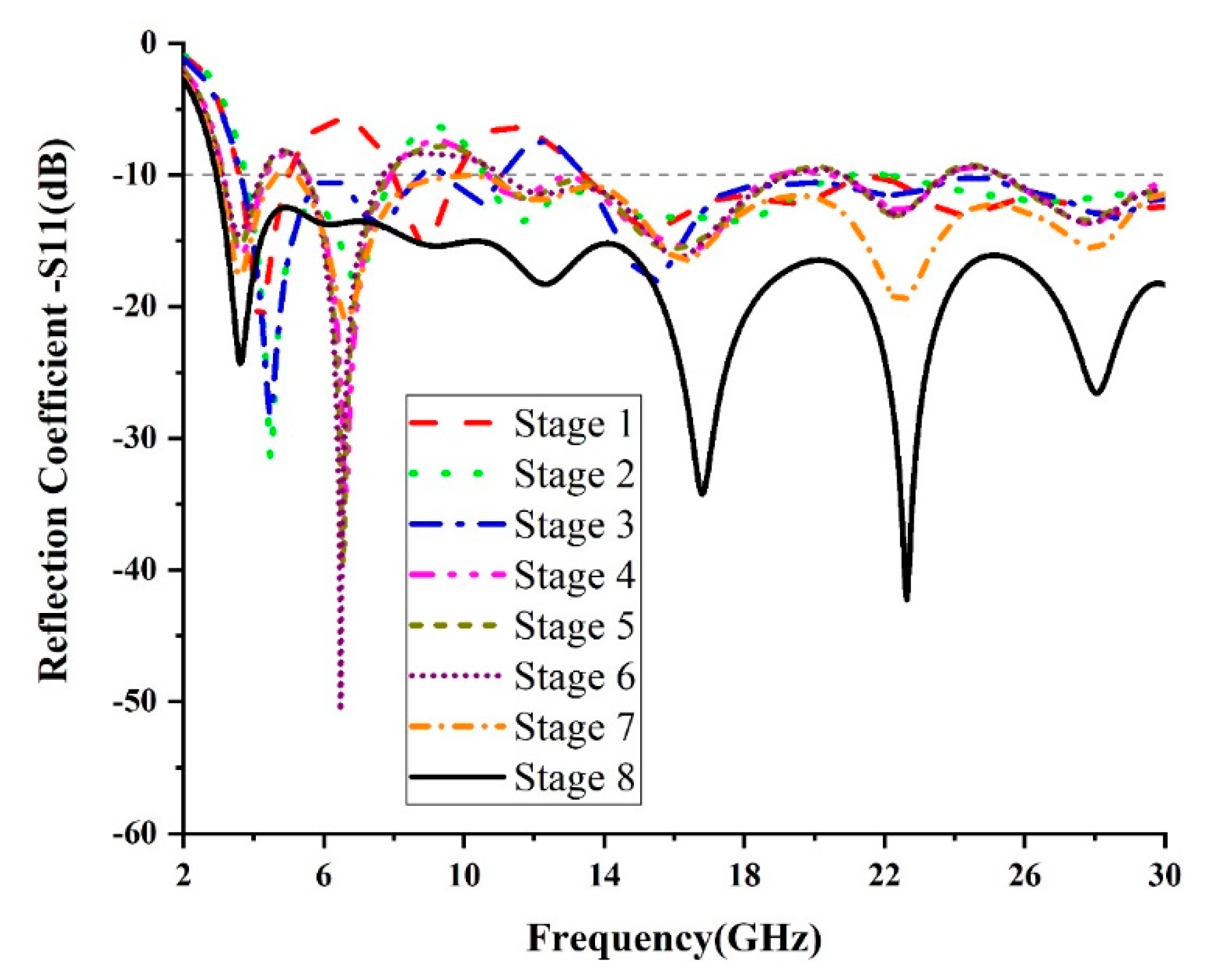





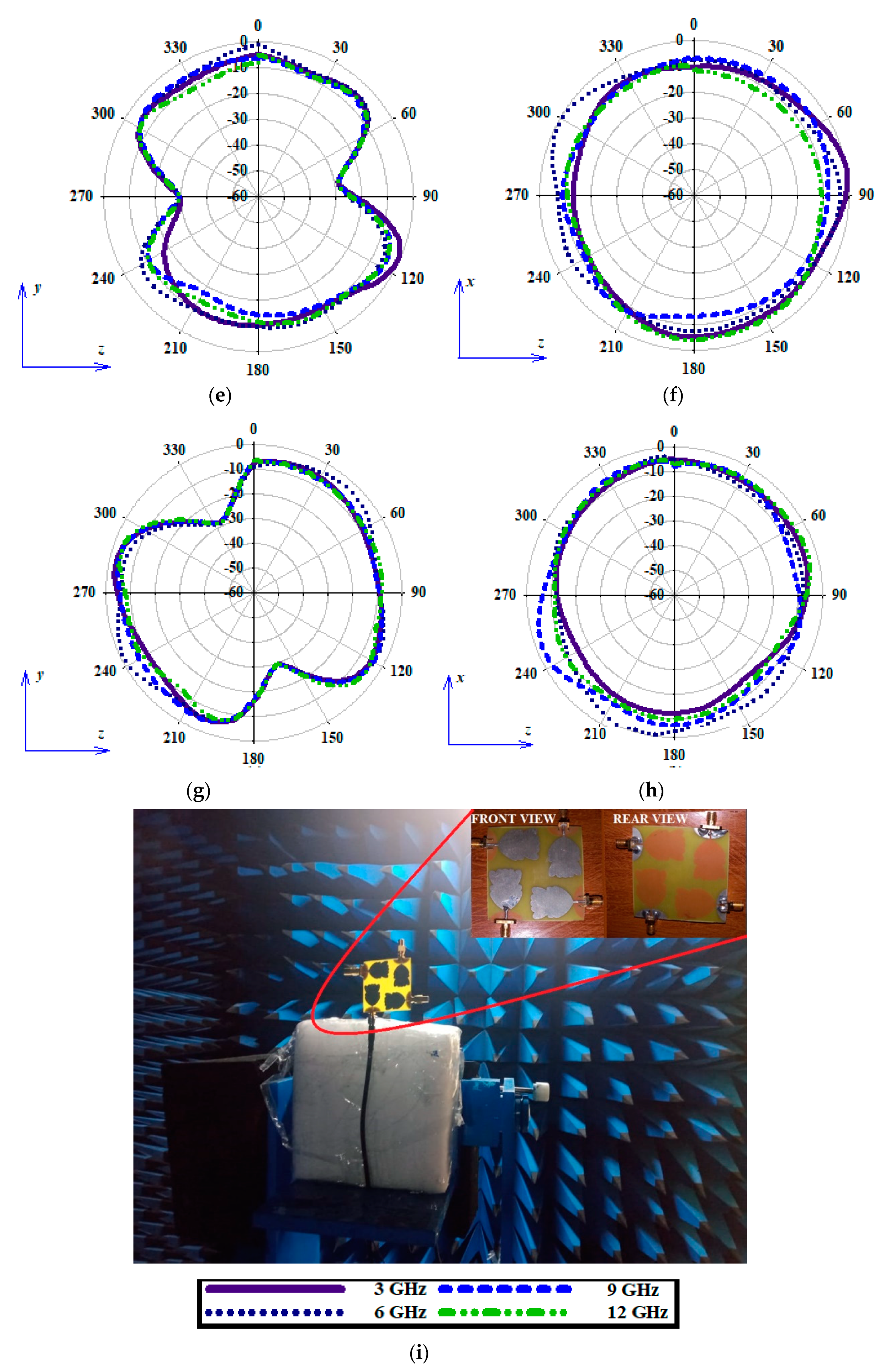
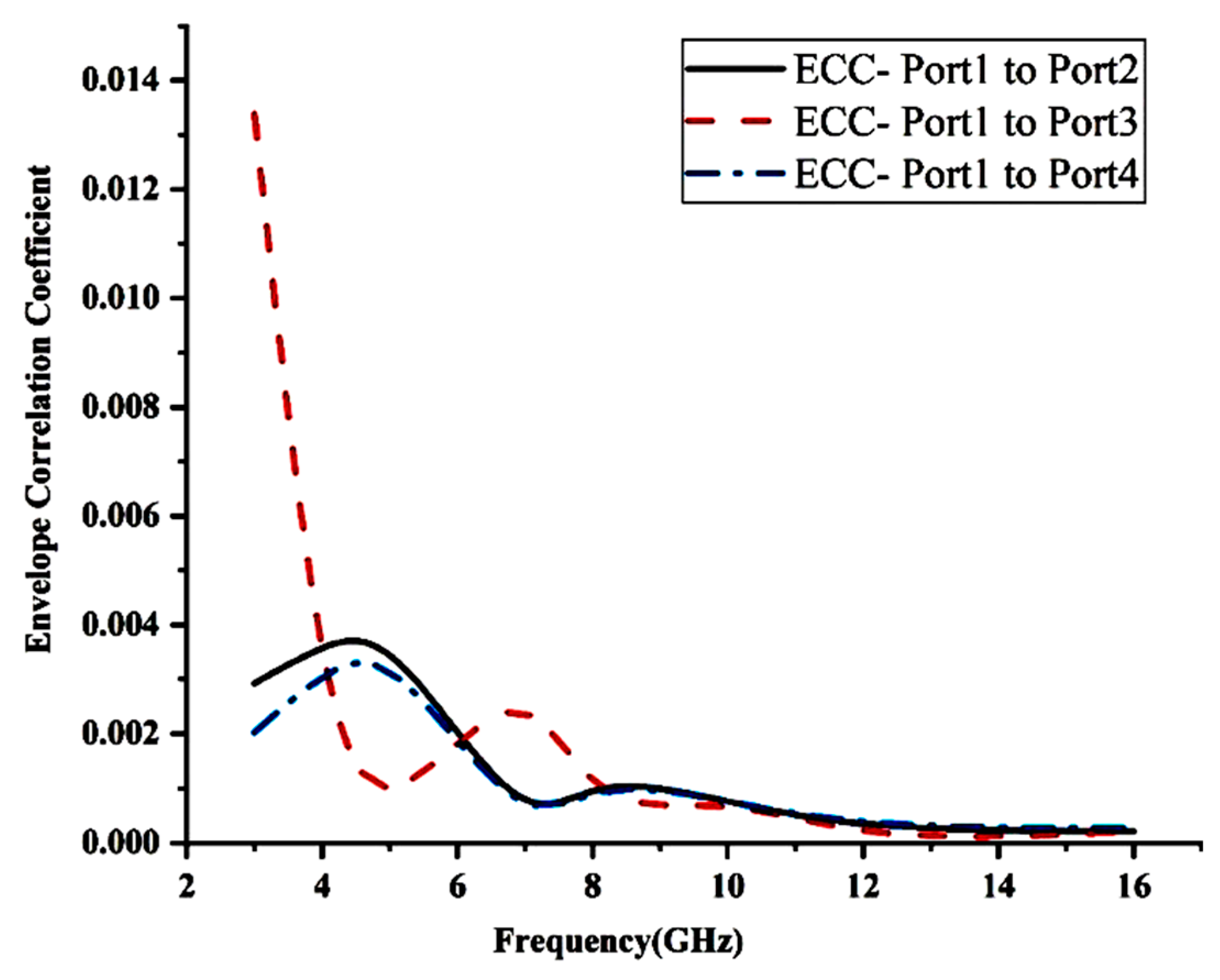
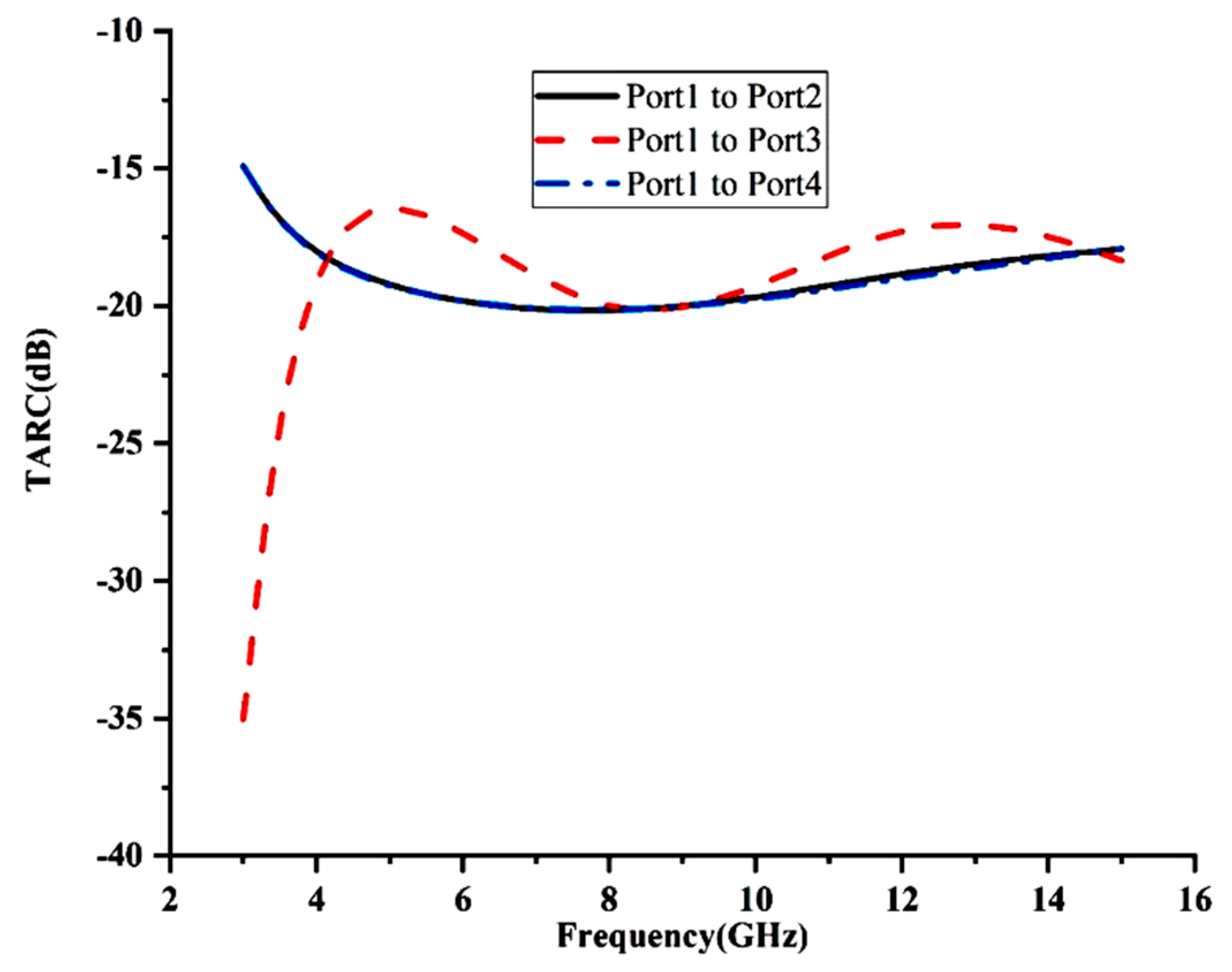
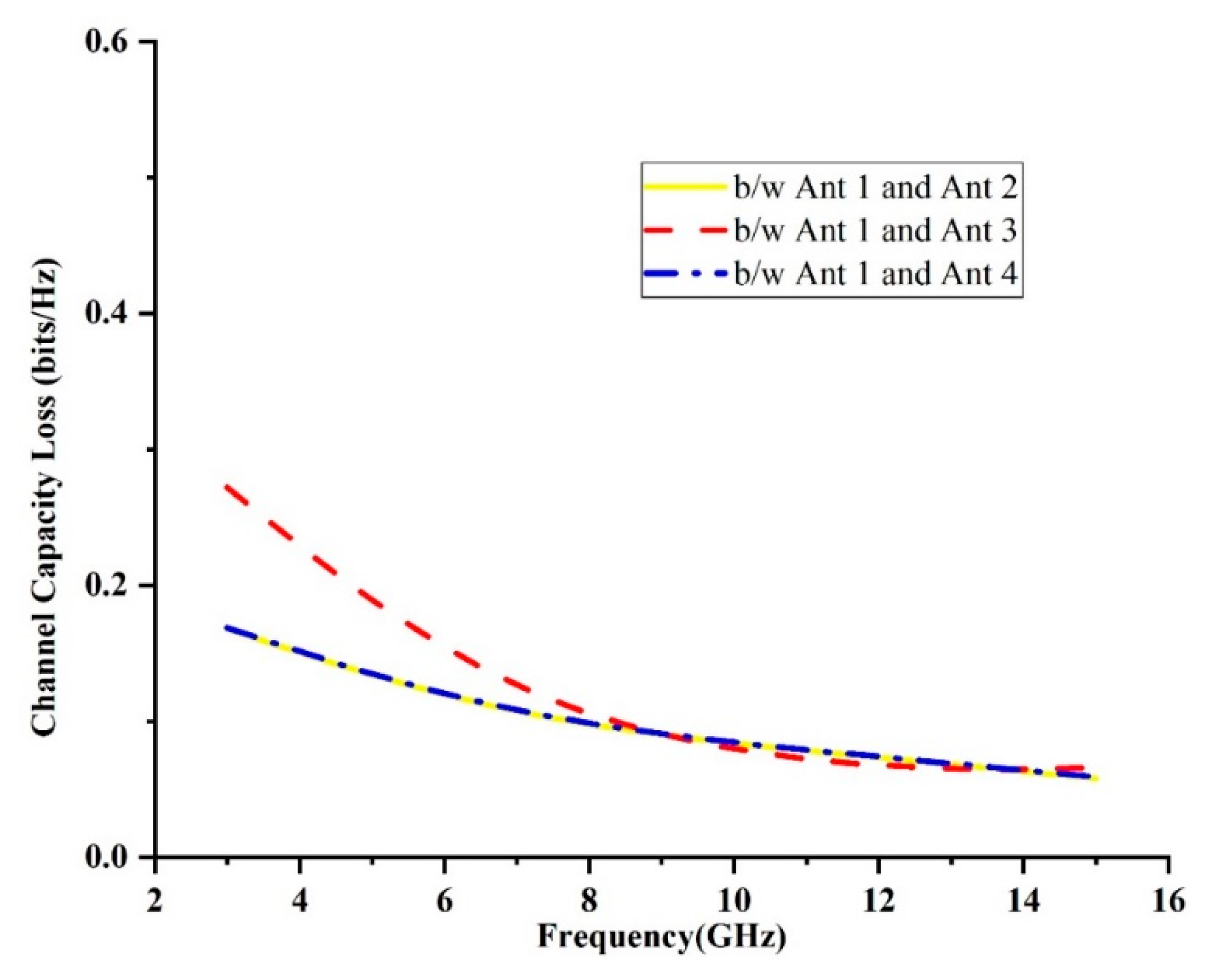
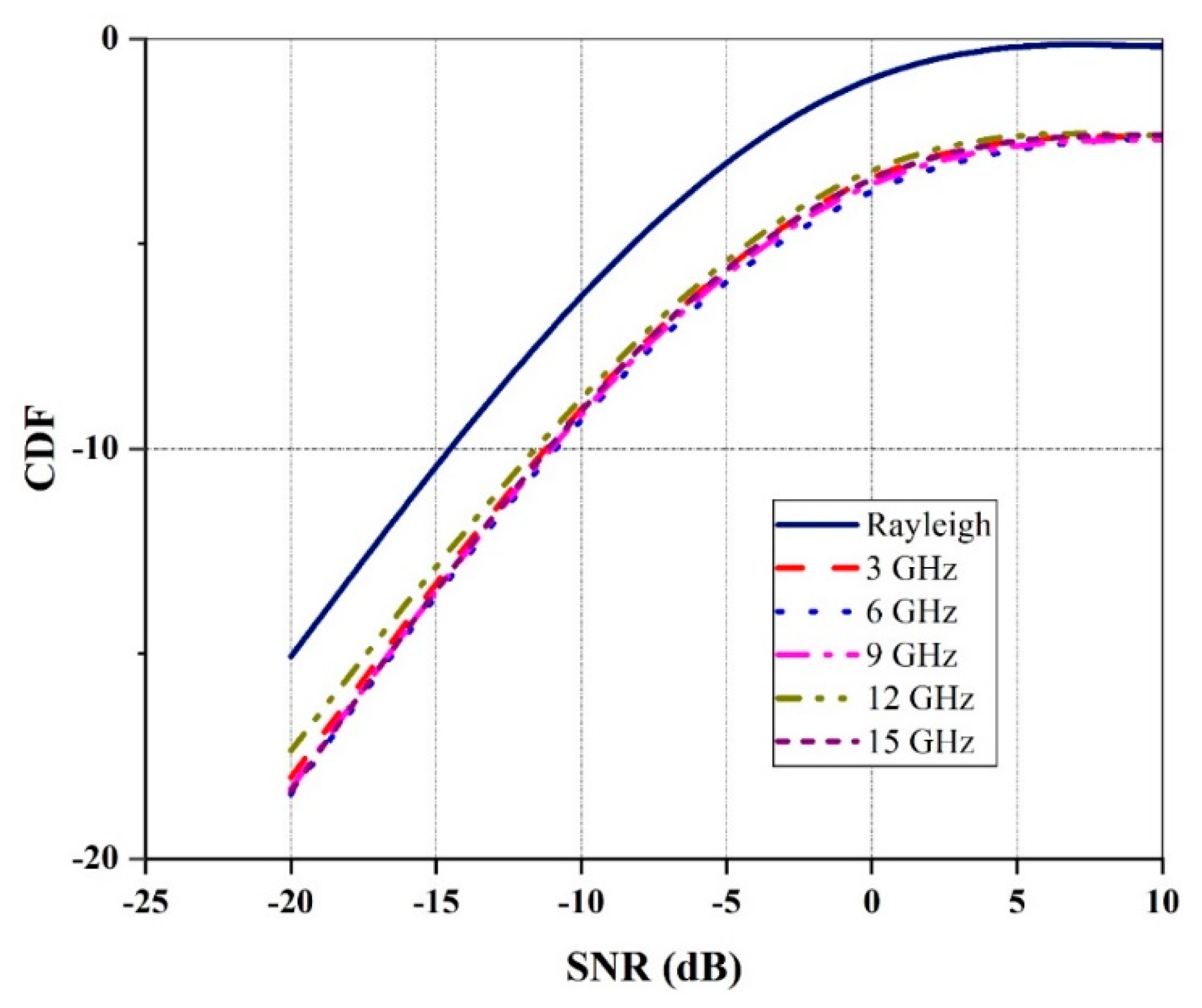
| Ref. | Unit Element Dimension (L × W in mm2, λL × λw) | MIMO Dimension (L × W in mm2, λL × λw) | No. of Elements | Bandwidth (GHz) | Bandwidth (%) | Spacing Between the Elements (mm, λ0) | Measured Isolation (dB) | Measured ECC | Measured DG (dB) | BDR |
|---|---|---|---|---|---|---|---|---|---|---|
| [17] | 26 × 29, 0.24 × 0.27 | 26 × 40, 0.24 × 0.37 | 2 | 8 | 117 | 9, 0.08 | >15 | <0.2 | - | 1317 |
| [18] | 40 × 17.5, 0.41 × 0.18 | 40 × 35, 0.36 × 0.41 | 2 | 7.5 | 109 | 3, 0.03 | >16 | <0.01 | >9.95 | 1476 |
| [19] | 24 × 16, 0.25 × 0.17 | 24 × 42, 0.25 × 0.43 | 2 | 7.8 | 111 | 7.6, 0.08 | >15 | <0.2 | >9.9 | 2690 |
| [20] | 38 × 38, 0.36 × 0.36 | 38 × 91, 0.35 × 0.85 | 2 | 5.2 | 100 | 15, 0.16 | >17 | <0.05 | - | 771 |
| [21] | 50 × 30, 0.5 × 0.3 | 50 × 60, 0.5 × 0.6 | 2 | 3 | 67 | 15, 0.15 | >13 | - | - | 446 |
| [22] | 35 × 30, 0.36 × 0.31 | 35 × 60, 0.36 × 0.62 | 2 | 6.9 | 105 | 5, 0.52 | >16 | <0.01 | - | 2100 |
| [23] | 47 × 47, 0.48 × 0.48 | 93 × 47, 0.96 × 0.48 | 2 | 7.5 | 109 | 33, 0.4 | >31 | - | - | 473 |
| [24] | 30 × 25, 0.25 × 0.21 | 50 × 30, 0.49 × 0.29 | 2 | 12 | 141 | 5, 0.06 | >20 | <0.04 | >7.4 | 2685 |
| [25] | 24 × 16, 0.26 × 0.17 | 24 × 32, 0.26 × 0.34 | 2 | 9.4 | 120 | 6, 0.06 | >16 | <0.05 | >9.9 | 2714 |
| [26] | 20 × 20, 0.21 × 0.21 | 40 × 40, 0.41 × 0.41 | 4 | 7.9 | 112 | 6.8, 0.07 | >20 | <0.002 | 9.92 | 2540 |
| [27] | 30 × 30, 0.27 × 0.27 | 60 × 60, 0.55 × 0.55 | 4 | 7.95 | 119 | 8, 0.09 | >15 | - | - | 1632 |
| [28] | 50 × 52, 0.33 × 0.35 | 122 × 122, 0.81 × 0.81 | 4 | 4 | 100 | 8.6, 0.13 | >25 | - | - | 865 |
| [29] | 25 × 22.5, 0.25 × 0.23 | 47 × 47, 0.47 × 0.47 | 4 | 9 | 120 | 10.6, 0.11 | >20 | <0.2 | - | 2086 |
| [30] | 30 × 30, 0.29 × 0.29 | 70 × 70, 0.66 × 0.66 | 4 | 11.15 | 132 | 10, 0.1 | >20 | - | - | 1570 |
| [31] | 25 × 25, 0.25 × 0.25 | 50 × 50, 0.5 × 0.5 | 4 | 9 | 120 | 6.4, 0.06 | >20 | - | - | 1920 |
| [32] | 40 × 40, 0.42 × 04.2 | 80 × 80, 0.85 × 0.85 | 4 | 8.32 | 113 | 15.2, 0.16 | >15 | <0.015 | >9.9 | 642 |
| [33] | 18.5 × 19.2, 0.3 × 0.15 | 27 × 27, 0.43 × 0.43 | 4 | 14.6 | 120 | 13, 0.21 | >15 | <0.005 | >9.9 | 2667 |
| [34] | 21 × 17, 0.25 × 0.2 | 48 × 34, 0.56 × 0.4 | 4 | 6.56 | 97 | 4, 0.05 | >23 | <0.039 | >9.81 | 1940 |
| Proposed | 32 × 20, 0.3 × 0.19 | 57 × 57, 0.5 × 0.5 | 4 | 27.1 | 165 | 5.1, 0.05 | >18 | <0.004 | >9.9 | 2894 |
| Frequency (GHz) | Mutual Coupling (dB) | ECC Using Far Field | Gapp (dB) | EDG (dB) | MEG |
|---|---|---|---|---|---|
| 3 | <−26.0 | 0.0031 | 9.98 | 7.78 | 0.981 |
| 6 | <−25.1 | 0.0012 | 9.99 | 8.51 | 0.992 |
| 9 | <−37.9 | 0.0007 | 9.99 | 8.09 | 0.997 |
| 12 | <−34.9 | 0.0002 | 9.99 | 9.48 | 0.999 |
Publisher’s Note: MDPI stays neutral with regard to jurisdictional claims in published maps and institutional affiliations. |
© 2020 by the authors. Licensee MDPI, Basel, Switzerland. This article is an open access article distributed under the terms and conditions of the Creative Commons Attribution (CC BY) license (http://creativecommons.org/licenses/by/4.0/).
Share and Cite
Boologam, A.V.; Krishnan, K.; Palaniswamy, S.K.; Manimegalai, C.T.; Gauni, S. On the Design and Analysis of Compact Super-Wideband Quad Element Chiral MIMO Array for High Data Rate Applications. Electronics 2020, 9, 1995. https://doi.org/10.3390/electronics9121995
Boologam AV, Krishnan K, Palaniswamy SK, Manimegalai CT, Gauni S. On the Design and Analysis of Compact Super-Wideband Quad Element Chiral MIMO Array for High Data Rate Applications. Electronics. 2020; 9(12):1995. https://doi.org/10.3390/electronics9121995
Chicago/Turabian StyleBoologam, Ananda Venkatesan, Kalimuthu Krishnan, Sandeep Kumar Palaniswamy, C. T. Manimegalai, and Sabitha Gauni. 2020. "On the Design and Analysis of Compact Super-Wideband Quad Element Chiral MIMO Array for High Data Rate Applications" Electronics 9, no. 12: 1995. https://doi.org/10.3390/electronics9121995





